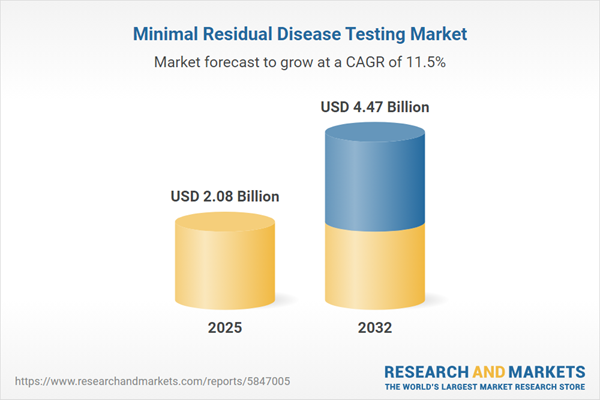Speak directly to the analyst to clarify any post sales queries you may have.
Minimal residual disease (MRD) testing is rapidly becoming an essential element of modern oncology workflows, enabling precise disease monitoring and more targeted treatment decisions across a spectrum of hematological malignancies and emerging solid tumor applications. Ongoing innovation and collaboration continue to reshape the global competitive landscape for MRD testing providers, offering new opportunities and challenges for healthcare systems, diagnostics developers, and biopharmaceutical stakeholders.
Market Snapshot: Minimal Residual Disease Testing Market Overview
The minimal residual disease testing market grew from USD 1.87 billion in 2024 to USD 2.08 billion in 2025 and is projected to reach USD 4.47 billion by 2032, reflecting a compound annual growth rate (CAGR) of 11.47%. This upward trajectory highlights strong demand for high-precision diagnostic tools that support early detection, robust therapeutic monitoring, and improved patient management in oncology. Recent advancements in molecular and cellular assay technologies have facilitated the integration of MRD testing into mainstream clinical practice, enhancing its role in guiding treatment pathways and supporting value-based care initiatives worldwide.
Scope & Segmentation
This research report provides a comprehensive analysis of the MRD testing market, segmented by technology, application, end-user verticals, and regions.
- Test Types: Cytogenetics (chromosomal microarray, fluorescence in situ hybridization); Flow cytometry (multi-parameter, single-parameter); Next-generation sequencing platforms (targeted and whole genome); Polymerase chain reaction modalities (digital PCR, quantitative PCR).
- Application Areas: Leukemia (acute lymphoblastic, acute myeloid, chronic lymphocytic); Lymphoma (Hodgkin's, non-Hodgkin's); Multiple myeloma; Solid tumors (breast cancer, colorectal cancer).
- End-User Verticals: Academic and research institutes; Biopharmaceutical companies; Diagnostic laboratories; Hospitals.
- Regional Coverage: Americas (United States, Canada, Mexico, Brazil, Argentina, Chile, Colombia, Peru); Europe, Middle East & Africa (United Kingdom, Germany, France, Russia, Italy, Spain, Netherlands, Sweden, Poland, Switzerland, United Arab Emirates, Saudi Arabia, Qatar, Turkey, Israel, South Africa, Nigeria, Egypt, Kenya); Asia-Pacific (China, India, Japan, Australia, South Korea, Indonesia, Thailand, Malaysia, Singapore, Taiwan).
Key Takeaways
- Market momentum is driven by synergistic advances in next-generation sequencing, digital PCR, and sophisticated flow cytometry, underpinning assay precision and throughput.
- Integration of MRD analysis into clinical decision-making empowers earlier intervention and supports therapeutic optimization, shaping personalized patient care strategies.
- Collaborative partnerships across diagnostic developers, academic centers, and biopharmaceutical companies are accelerating assay validation, clinical adoption, and standardization.
- Expansion into solid tumor diagnostics is broadening MRD testing’s clinical relevance, enabling prognostic and monitoring solutions beyond hematological cancers.
- Reimbursement policy evolution and improved regulatory frameworks reinforce adoption, with regional initiatives fostering greater accessibility and innovation.
Tariff Impact: United States Supply Chain and Regulatory Dynamics
The introduction of new tariffs in the United States in 2025 has injected cost and operational complexity across the MRD testing value chain. Imported analytical instruments, reagents, and consumables now encounter increased duties, prompting diagnostic laboratories to recalibrate supply contract strategies and seek dual sourcing arrangements to balance lead time and inventory risks. Regulatory compliance obligations have intensified, requiring manufacturers and service providers to navigate overlapping trade and quality standards. In regions affected by tariffs, strategic partnerships and localized distribution models are emerging, helping to mitigate disruptions and preserve service continuity.
Methodology & Data Sources
This report is grounded in a rigorous mixed-methodology approach, synthesizing peer-reviewed literature, regulatory publications, proprietary data, and real-world evidence. Primary research included semistructured interviews with laboratory directors, oncology clinicians, and R&D executives, while quantitative triangulation ensured consistency and representativeness of market insights. Analytical frameworks were validated through iterative collaboration with subject matter experts across the MRD ecosystem.
Why This Report Matters
- Supports senior leaders in benchmarking their organization’s MRD testing strategies and identifying partnership opportunities with innovators and key opinion leaders.
- Arms decision-makers with granular insights into test types, application trends, regulatory shifts, and evolving reimbursement mechanisms, facilitating scalable investment and integration planning.
Conclusion
Minimal residual disease testing continues to advance the precision oncology paradigm, supporting targeted clinical decisions and strengthening the outlook for patient outcomes. Strategic adoption of MRD insights positions stakeholders competitively as the market evolves.
Additional Product Information:
- Purchase of this report includes 1 year online access with quarterly updates.
- This report can be updated on request. Please contact our Customer Experience team using the Ask a Question widget on our website.
Table of Contents
3. Executive Summary
4. Market Overview
7. Cumulative Impact of Artificial Intelligence 2025
Companies Mentioned
The companies profiled in this Minimal Residual Disease Testing market report include:- Agilus Diagnostics Ltd.
- Amgen Inc.
- Adaptive Biotechnologies Corporation
- ARUP Laboratories
- AstraZeneca PLC
- Asuragen Inc. by Bio-Techne Corporation
- Bio-Rad Laboratories, Inc.
- Bristol-Myers Squibb Company
- C2I Genomics Inc.
- Cergentis B.V.
- Exact Sciences Corporation
- F. Hoffmann-La Roche Ltd.
- Genetron Holdings Limited
- GRAIL, LLC by Illumina, Inc.
- Guardant Health, Inc.
- Integrated DNA Technologies, Inc.
- Invivoscribe, Inc.
- Kite Pharma, Inc. by Gilead Sciences, Inc.
- Laboratory Corporation of America Holdings
- Mdxhealth BV
- MedGenome Inc
- Mission Bio, Inc.
- Myriad Genetics, Inc.
- Natera Inc.
- NeoGenomics Laboratories, Inc.
- OPKO Health, Inc.
- Quest Diagnostics incorporated
- Sysmex Corporation
- Veracyte, Inc.
Table Information
| Report Attribute | Details |
|---|---|
| No. of Pages | 192 |
| Published | November 2025 |
| Forecast Period | 2025 - 2032 |
| Estimated Market Value ( USD | $ 2.08 Billion |
| Forecasted Market Value ( USD | $ 4.47 Billion |
| Compound Annual Growth Rate | 11.4% |
| Regions Covered | Global |
| No. of Companies Mentioned | 30 |









